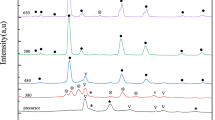Abstract
Cu2ZnSnS4 (CZTS) is a promising alternative for Cu(In,Ga)Se2 (CIGS) absorber layers in thin film solar cells and is comprised of commodity elements which will enable scale-up of chalcopyrite panel production unhindered by elemental supplies and costs. Various CZTS synthesis methods, especially sulfurization of stacked metal or metal sulfide layers, are being studied and have led to cell efficiencies up to 6.7% [1]. Here we report our studies of CZTS thin film synthesis via room temperature sputtering from a single CZTS target and co-sputtering from Cu2S, ZnS and SnS2 binary targets, both followed by sulfurization between 500 C - 600 C using either elemental sulfur vapor or in-situ generated H2S. Sputtering from sulfur-containing targets is designed to increase the sulfur content in the precursor films to promote stoichiometry. We report on the effects of processing including deposition on soda-lime and borosilicate glasses and deposition of Na-containing layers on film morphology (AFM/SEM), composition (EDS), phase (XRD), grain size (XRD/EBSD), grain boundary structure (EBSD), optical (spectroscopic ellipsometry) and electrical properties. Processing conditions producing desirable Zn-rich/Cu-poor films are identified [1]. The formation of MoSe2 at Mo/CIGS interface is believed to promote Ohmic contacts, but in CZTS we associate excessive formation of frangible MoS2 with film delamination from Mo/borosilicate glass substrates. Strategies for preventing delamination including adhesion layers are investigated and discussed. P-N junctions are formed with CdS/ZnO using chemical bath deposition and sputtering, and I-V characteristics are reported. Schottky junctions are formed and C-V measurements are used to determine the doping in the CZTS absorber layers.[1] H. Katagiri, et al., MRS Symp. Proc. 1165 1165-M04-01 (2009).
Similar content being viewed by others
References
H. Katagiri et al., Applied Physics Express, 1 041201 (2008).
The rise of thin film solar power, The Economist, Oct (2009).
S. Chen et al., Applied Physics Letters 96 021902 (2010).
J. L. Johnson et al., Mater. Res. Soc. Symp. Proc. EE3. 3 (2010).
S. Schorr & G. Gonzalez-Aviles, Thin Solid Films 517 2461 (2009).
G. Springer, Canadian Mineralogist 11 535 (1972).
H. Katagiri et al., Mater. Res. Soc. Symp. Proc. 1165-M04-01 (2009).
P.A. Fernandes et al., Semicond. Sci. Technol. 24 105013 (2009).
S. Siebentritt and U. Rau, Eds., Wide-Gap Chalcopyrites, (Springer, 2006).
R.N. Bhattacharya et al., Japanese Journal of Applied Physics, Vol 43, No. 11B (2004)
Author information
Authors and Affiliations
Rights and permissions
About this article
Cite this article
Nukala, H., Johnson, J.L., Bhatia, A. et al. Synthesis of Optimized CZTS Thin Films for Photovoltaic Absorber Layers by Sputtering from Sulfide Targets and Sulfurization. MRS Online Proceedings Library 1268, 304 (2010). https://doi.org/10.1557/PROC-1268-EE03-04
Received:
Accepted:
Published:
DOI: https://doi.org/10.1557/PROC-1268-EE03-04




